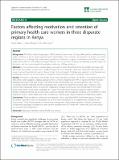Factors Affecting Motivation and Retention of Primary Healthcare Workers in Three Disparate Regions in Kenya
View/
Publication Date
6/6/2014Type
Article, Journalviews
downloads
Metadata
Show full item recordCitation
Ojakaa, D., Olango, S. & Jarvis, J. Factors affecting motivation and retention of primary health care workers in three disparate regions in Kenya. Hum Resour Health 12, 33 (2014). https://doi.org/10.1186/1478-4491-12-33
Abstract/
Background The World Health Organization (WHO) and the Government of Kenya alike identify a well-performing health workforce as key to attaining better health. Nevertheless, the motivation and retention of health care workers (HCWs) persist as challenges. This study investigated factors influencing motivation and retention of HCWs at primary health care facilities in three different settings in Kenya - the remote area of Turkana, the relatively accessible region of Machakos, and the disadvantaged informal urban settlement of Kibera in Nairobi. Methods A cross-sectional cluster sample design was used to select 59 health facilities that yielded interviews with 404 health care workers, grouped into 10 different types of service providers. Data were collected in November 2011 using structured questionnaires and a Focus Group Discussion guide. Findings were analyzed using bivariate and multivariate methods of the associations and determinants of health worker motivation and retention. Results The levels of education and gender factors were lowest in Turkana with female HCWs representing only 30% of the workers against a national average of 53%. A smaller proportion of HCWs in Turkana feel that they have adequate training for their jobs. Overall, 13% of the HCWs indicated that they had changed their job in the last 12 months and 20% indicated that they could leave their current job within the next two years. In terms of work environment, inadequate access to electricity, equipment, transport, housing, and the physical state of the health facility were cited as most critical, particularly in Turkana. The working environment is rated as better in private facilities. Adequate training, job security, salary, supervisor support, and manageable workload were identified as critical satisfaction factors. Family health care, salary, and terminal benefits were rated as important compensatory factors. Conclusions There are distinct motivational and retention factors that affect HCWs in the three regions. Findings and policy implications from this study point to a set of recommendations to be implemented at national and county levels. These include gender mainstreaming, development of appropriate retention schemes, competitive compensation packages, strategies for career growth, establishment of a model HRH community, and the conduct of a discrete choice experiment.
Further Details
This article is published under license to BioMed Central Ltd. This is an Open Access article distributed under the terms of the Creative Commons Attribution License (http://creativecommons.org/licenses/by/2.0), which permits unrestricted use, distribution, and reproduction in any medium, provided the original work is properly credited. The Creative Commons Public Domain Dedication waiver (http://creativecommons.org/publicdomain/zero/1.0/) applies to the data made available in this article, unless otherwise stated.
Publisher
BioMed CentralISSN
1478-4491Collections
- General - GEN [367]

